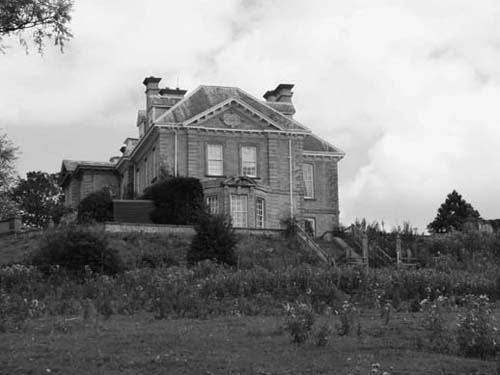Read Folklore of Lincolnshire Online
Authors: Susanna O'Neill
Folklore of Lincolnshire (17 page)
Rudkin describes an exorcism to rid the Manor Farm at East Halton of a ghost, another possible poltergeist, although she indicates the haunting might have been connected with monks who used to live there. So disturbing were the events that occurred that the only apparent solution was to trap the evil spirit in an iron pot and keep it in the cellar. The occupants of the house were told not to move the pot, for fear of bad luck – and certainly not to open it, as the spirit would be let loose once again.
Another incident of a spirit being captured in an iron pot occurred at Normanby-by-Spital. The legend tells that it took twelve parsons to lay this spirit, who was said to be very obnoxious and vindictive. They apparently asked what it wanted and it replied ‘Life I want, life I’ll have’.
4
So the parsons threw it a live cock which, it is claimed, was torn limb from limb and devoured. This caused the distraction the parsons needed and whilst it was busy with the cock, they lowered the iron pot over it, which was then somehow pushed into the ground. It seems that spirits do not like iron! They say that placing an iron rod across a grave will prevent ghosts from rising out of the ground and an iron horseshoe at the entrance to a building will stop ghosts from coming in. With this in mind, let us hope both iron pots work, especially for the sake of the present-day inhabitants there!
As well as poltergeist activity, Lincolnshire has many a poor ghost, victims of none other than love – unrequited love, love lost, love turned to hatred and thwarted love. Love has a lot to answer for!
The ghost of Tom Otter is perhaps one of the better known Lincolnshire ghosts. His was a simple tale of a young man and woman falling in love. It was 1800
when he travelled to Lincoln looking for work and met the fair Mary Kirkham. They courted and soon she became pregnant. Her father demanded Tom either marry the girl or go to jail, so he kept quiet about the fact that he was already a married man and married Mary in 1805. However, the next day Mary’s body was found in a lane; she had been murdered with a hedge stake. Tom, of course, was arrested and went on trial at the Sun Inn, Saxilby. Mary’s body was also taken there and her blood, which was said to have spilled onto the steps, stained them for many years afterwards, despite vigorous attempts to clean it away. The room where her body was placed is said to be haunted by the cries of a new-born baby.
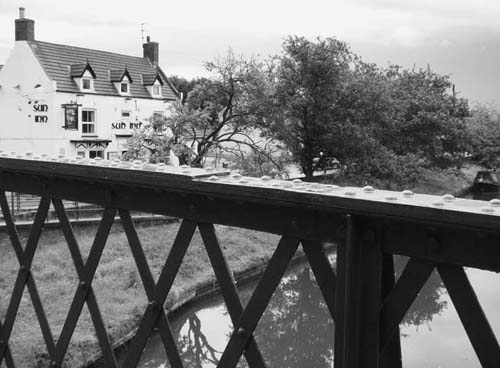
The Sun Inn, Saxilby, where Tom Otter was tried for the murder of his wife and where poor Mary Kirkham’s spirit still roams. Above the fireplace, where the murder weapon was once kept, is a photograph of how the inn used to look and some information regarding the story.
Tom was hanged and then his body, fastened in an iron cage, was hung up high for everyone to see. It is said the body fell down twice, due to the weight of the iron, and the second time it killed a man.
The murder weapon was kept above the fireplace at the Sun Inn but every year on the anniversary of the murder, it was mysteriously moved, although the inn was locked and the weapon securely fastened with iron strapping or staples. On each occasion, it was discovered at the murder site, covered in what appeared to be fresh blood. There used to be a saying in Lincoln when ordering a new rope or chain required to be very strong: ‘Ma’ke it strong enough to hold Tom Otter’s hedge stake.’
The stake was eventually burned by the Bishop of Lincoln in the hope that the ghost would be laid to rest. The lane where Mary was found is now called Tom Otters Lane (the B1190) and his body was left hanging there until a storm in 1850 blew what remained of the gibbet down. Some say that part of the gibbet was taken to be displayed at Doddington Hall.
His body had been on public display for so long that he had become quite famous, notwithstanding the eerie incidents that also drew the crowds. When his body was old and rotting, birds would make nests in his skull and there was a rhyme that existed even after his gibbet fell:
There were nine tongues within one head;
The tenth went out to seek for bread;
To feed the living within the dead.
5
With all the mysterious happenings surrounding this story some people have speculated as to whether Tom was the real murderer or perhaps just the scapegoat? Could this be why there was so much unrest in the spirit world regarding the murder of Mary Kirkham?
Gainsborough Old Hall is one site of many with a ghost that harbours a broken heart. The Grey Lady is this particular phantom, who has been seen on numerous occasions floating along the corridors with her long dress swishing beneath her. She frequents the East Wing corridor near the tower and disappears into the wall. Apparently, during some renovations in the 1940s, part of the wall in that corridor was stripped back and a doorway was found beneath it. Legend states this is the doorway the Grey Lady comes through, looking for her forbidden lover. As daughter of Lord of the Manor, she was not allowed to marry her soldier sweetheart and when her father discovered plans for an elopement he exiled her to the tower where she pined away her years, nursing her broken heart.
William Rose, after whom Roses Trentside Albion Works is named, spent much of his childhood in the 1800s at the Old Hall. He is said to have encountered the Grey Lady during this period, a tale that he told, even in his late years, with such detail that it must have made quite an impression on him. She has become an attraction at the house now and her spirit is said still to wander.
Gunby Hall boasts a similar, if somewhat more gruesome, story. Sir William Massingberd had the hall built for himself in 1700 after a regrettable incident. His daughter, Margaret, unfortunately fell passionately in love with one of his postilion riders who rode the lead horse on her father’s coach, an affair of which Massingberd thoroughly disapproved. The lovers attempted a secret elopement but were discovered, and in a furious temper Massingberd shot the rider dead and hid his body in the pond. Some versions say he also shot his daughter and threw them both in. The path near the pond is now known as the Ghost Walk, for this is where the lovers are reputed to walk for eternity, not to be parted even by death. Alfred Lord Tennyson enjoyed spending time at Gunby Hall, describing it as ‘a haunt of ancient peace’, and now a National Trust property it is certainly worth a visit, as the grounds are indeed a haven, if you avoid crossing the lovers!
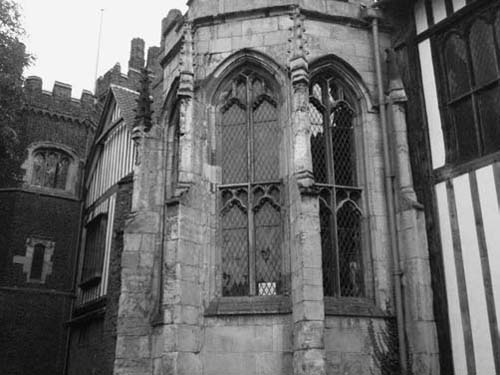
Gainsborough Old Hall, open to the public, is a fascinating building to visit. Each part of the structure has been built at differing time periods and in varying styles.
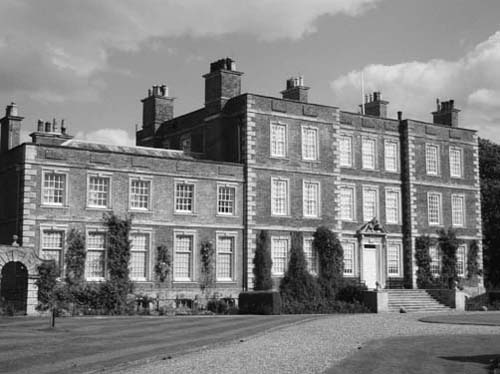
Gunby Hall, near Spilsby; open to the public.
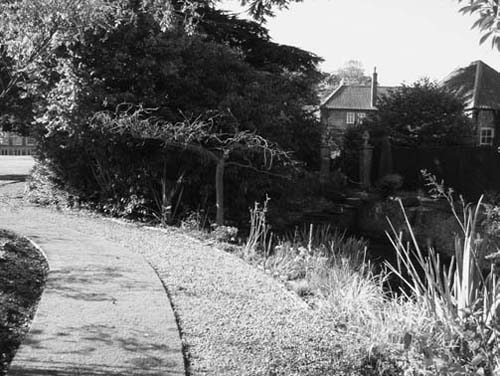
The Ghost Walk in the grounds of Gunby Hall, along the side of the carp pond, on the way to the church. This is where the ghosts of the lovers are said to be seen.
Rudkin describes another lovelorn tragedy that occurred at Fillingham Castle:
But the castle itself is ‘aunted – because a man as once lived there cut ‘is throat or else shot ‘isself on the front door step, an’ all along of a lady’s ‘avin’ jilted ‘im; an’ at night ‘is spirit ‘aunts the great long corridors because ‘e can’t rest.
6
However, another report states that a Green Lady haunts the castle, the ghost of a girl who committed suicide after her beloved left her.
Harmston Hall,
7
near Waddington, holds a mystery that has never been satisfactorily explained. The story tells that during the time of George IV, the family in residence at the hall suddenly departed one night, never to return. When the hall was opened some thirty years later to have an inventory taken, the dining room was found exactly as it had been the evening the family left, except for a film of dust and cobwebs, not unlike Miss Havisham’s wedding banquet. Chairs were apparently lying where they had been bowled over, wine glasses had been knocked on the floor in the rush to leave – there was even wine left in the decanters. Something quite terrifying must have happened for them to flee in such a manner. Officially, people said that the squire had just found out his wife had been having an affair with his best friend. He had sent everyone away that very hour and locked up the house, then left. Strangely neither the wife nor the friend were ever seen again and rumour spread that they had been murdered and buried under the hearth in that very room.
Years later, a gentleman farmer took the hall but he and his family claimed it was terribly haunted. Screams would be heard every night and the sounds of a fight or struggle. Footsteps running along the passage and the sound of a body falling against a door were common occurrences. No family ever stayed very long in that house, and in 1930 it became part of a new mental health hospital complex. This complex, as you can imagine, had its fair share of supernatural happenings and was finally closed down in 1990. Since then, it was redeveloped to become a private home again. One wonders what disturbances, if any, remain.
The Irby Boggle is reputed to haunt Irby Dale Woods. In 1455, Rosamund Guy and Neville Randell, who were betrothed, allegedly met for a romantic tryst in the woods the night before their wedding. Apparently the rendezvous turned into a violent quarrel and ended in the murder of Rosamund, although her body was not found. The story states that no one saw them after they went for their walk, but people from the village heard their shouting and speculation grew. Rosamund’s father swore that justice for his daughter must be done, or else her ghost would haunt Irby Dale Wood for 500 years.
Witnesses have seen a spirit in what is believed to be a white wedding dress, walking in the woods, and legend states that many years later some workmen uncovered the skeleton of a woman underneath the branches of an oak into which, as lovers, they had carved their initials. What the argument was about no one ever knew, but Neville was never brought to justice for his actions, leaving Rosamund’s ghost to wander the woods for 500 years.
